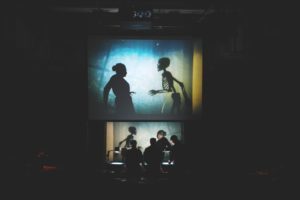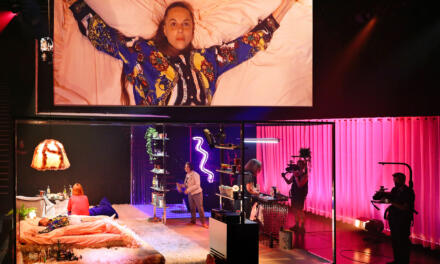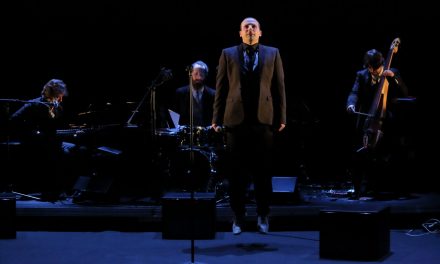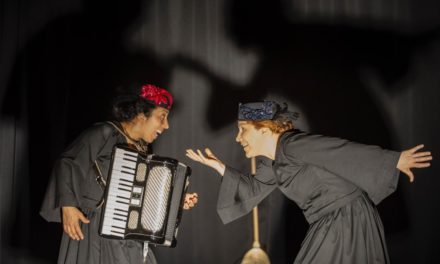ArtsEmerson is dedicated to bringing compelling and experimental theatre from all parts of the world to Boston. On January 10, Manual Cinema, a company that devises works that cross the line between cinema and theatre brought Ada/Ava to ArtsEmerson’s Paramount Theatre. First produced in 2013, Ada/Ava is the second full-length production by this young Chicago collective of five. Since then they have added three more productions and become known in the US and abroad.
Although Manual Cinema has its roots in shadow puppetry, they take pride in their films which are created anew at each performance in full sight of the audience. Onstage for Ada/Ava are live puppeteers, a woman at a computer, and musicians sitting at a table as well as two actresses who spend most of their time performing. Puppeteers create hundreds of drawings on transparent paper lit by dated overhead projectors. There are two screens, a lower one against which the action is filmed and a higher one where it is seen in reverse with the performers as silhouettes. Audience members are free to choose where to place their concentration. While spoken words are not used, sound plays a significant role throughout the piece.
Set in New England around the beginning of the twentieth century, the story concerns two elderly identical twins, Ada and Ava, who live in a small New England home near a lighthouse where they replace the light as needed. Interspersed between the adult scenes are moments from their youth. They are extremely close and have been since childhood. The tandem bicycle, which they still ride in later life, exemplifies their intimacy. Ada and Ava often stay at home playing chess and drinking tea. The house is old fashioned and decorated with shadow pictures of the sisters. On one ordinary day, Ava dies in the midst of a chess game, leaving Ada forlorn. Ava is buried to the sounds of bells, thunder, and rain.
Alone for the first time Ada stumbles through life bewildered. She looks in the mirror and is reminded of her sister. She accidentally burns the tea kettle and to replace it finds herself wandering through Box Mart, an exaggeratedly ultramodern shop.
She becomes demented. A carnival comes to the area–or seems to–similar to the one Ada and Ava saw as young girls. Ada enters a maze of mirrors and believes her reflection is actually Ava. Following an arrow that points downward, Ada descends where again she sees her reflection. But this time Ada pulls Ava out of the mirror.
The film slips and slides chronologically. We see the sisters as girls on the beach. Then the dead Ava begins to turn into a skeleton, starting with her hand. While Ada covers it with a potholder, the other hand begins to change. She places a hat on her sister’s naked scalp.
Eventually, the dead sister returns to the cemetery. There is a storm outside. A completely formed skeleton knocks on the door and enters. Ada runs. The story becomes more nightmarish as the two women find themselves on top of the lighthouse and appear to jump or fall.
Most of the film is black and white with moments of pale color. When Ada plants a flower in front of the grave it is in full color.
One source for the script was the recent death of director Drew Dir’s grandmother and the mourning of his bereaved grandfather. Alfred Hitchcock’s thriller Vertigo was another.
Ada/Ava ends with Maren Celest, one of the musicians and sound effect technicians, singing a moving rendition of All Of Me. The show is slick, clever, moving, grotesque, and well worth seeing.
Ada/Ava played at Emerson Paramount Center.
D
This article was first published in Capital Critics’ Circle on January 12, 2018, and has been reposted with permission.
This post was written by the author in their personal capacity.The opinions expressed in this article are the author’s own and do not reflect the view of The Theatre Times, their staff or collaborators.
This post was written by Jane Baldwin.
The views expressed here belong to the author and do not necessarily reflect our views and opinions.


















